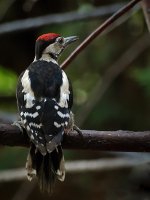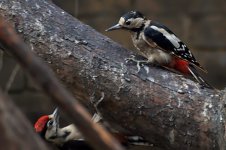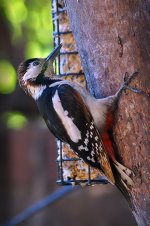ChrisKten
It's true, I quite like Pigeons
Earlier this year, I posted a pic of an "ism-istic" (I just made that up  ) Great Spotted Woodpecker - the consensus was it was a female with either Leucism or Erythrism. She's been visiting the garden regularly, and I was curious as to how her young would be affected... Would she find a mate and breed normally? Would her young inherit her condition? etc. I thought a few others in the forum might be interested as well.
) Great Spotted Woodpecker - the consensus was it was a female with either Leucism or Erythrism. She's been visiting the garden regularly, and I was curious as to how her young would be affected... Would she find a mate and breed normally? Would her young inherit her condition? etc. I thought a few others in the forum might be interested as well.
Well, I got both answers this morning. As you can see from the pics (poor light through double glazing etc), she bred successfully, and this youngster looks completely normal. I couldn't get a decent pic of them interacting, as they was trying to avoid the Squirrels that were charging through my trees, but I've attached one blurry pic of them together. They arrived together and left together, so I'm pretty sure it's mother and her youngster... but without a feeding pic, I guess there's room for doubt.
So I guess either it's skipped a generation, or maybe signs of Leucism/Erythrism will show after post-juvenile moult. I'll keep my eye on how the youngster develops... assuming one of the Sparrowhawks doesn't get it.
Oh, one other thing; I'm pretty sure the male died (I posted a pic of him looking like he was quite ill), so she's brought this youngster up on her own.
Well, I got both answers this morning. As you can see from the pics (poor light through double glazing etc), she bred successfully, and this youngster looks completely normal. I couldn't get a decent pic of them interacting, as they was trying to avoid the Squirrels that were charging through my trees, but I've attached one blurry pic of them together. They arrived together and left together, so I'm pretty sure it's mother and her youngster... but without a feeding pic, I guess there's room for doubt.
So I guess either it's skipped a generation, or maybe signs of Leucism/Erythrism will show after post-juvenile moult. I'll keep my eye on how the youngster develops... assuming one of the Sparrowhawks doesn't get it.
Oh, one other thing; I'm pretty sure the male died (I posted a pic of him looking like he was quite ill), so she's brought this youngster up on her own.







